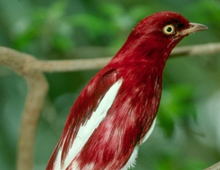Description: Xiphlonea punicea is one of three species in this very distinct genus. The males have very deep crimson or purplish black plumage with white flight-feathers. The tips of the major coverts (one of the small feathers covering the bases of the longer feathers of a bird’s wings or tail) are stiffened and elongated to form spear-like spikes that partially conceal the folded flight-feathers. The females are a drab gray and have white under- bellies. Their bill is wide at the base and rather flattened with a slightly hooked tip.
Size: X. punicea is the largest of this genus, weighing approximately 2.47 ounces (70 gr).
Behavior: The males use a chasing ritual to display for females. The dominant male will chase the lesser males from tree top to tree top while fluttering its wings. There is a definite order of dominance among males, whether two or more are present. The process is a silent one.
Diet: They are completely frugivorous and prefer figs.
Communication: The Pompadour cotinga is described as a noisy bird with a frog-like croak that can be mistaken for tree frogs.
Reproduction: They use small, but deep open cups made of curly woody tendrils for their nest, which is normally placed in a tree above 60 feet (18.3 m). The egg is pale to light greenish gray with spots and blotches of a drab color.
Habitat/range: The Pompadour cotinga is found throughout Venezuela, Colombia and the Guianas. Some reports have been made in eastern Peru and northern Brazil.
Status: Listed as Least Concern on the IUCN Red List.



